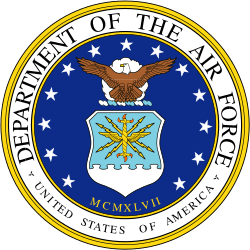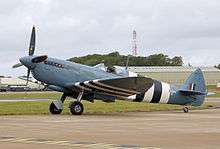Air Force blue
Air Force blue colours are a variety of colours that are mostly various tones of the colour azure, the purest tones of which are identified as being the colour of the sky on a clear day.
Some air force blue colours, notably the air force blue colour used by the United States Air Force and the colour used by the US Air Force Academy, may look like they are tones of blue instead of azure.[lower-alpha 1] However, they are actually dark tones of azure, not blue.[lower-alpha 2]

These air force blue colours are used by these various air forces for colour identification.
RAF blue
| Air Force Blue (RAF) | |
|---|---|
| Hex triplet | #5D8AA8 |
| sRGBB (r, g, b) | (93, 138, 168) |
| CMYKH (c, m, y, k) | (45, 18, 0, 34) |
| HSV (h, s, v) | (204°, 45%, 66%) |
| Source | Vexillological:[1] |
| ISCC–NBS descriptor | Moderate greenish blue |
| B: Normalized to [0–255] (byte) H: Normalized to [0–100] (hundred) | |
Air Force blue, more specifically Air Force blue (RAF) or RAF blue, is a medium shade of the colour azure. The shade derives from the light blue uniforms issued to the newly formed British Royal Air Force in 1920, which were influential in the design of the uniforms of some other air forces around the world. Similar shades are still used in Royal Air Force uniforms and the Royal Air Force Ensign.
The choice of blue uniforms for the RAF was the result of a surplus of inexpensive medium sky blue coloured herringbone twill in the United Kingdom, which had been intended for use in the uniforms of Czarist Russian imperial cavalrymen before the Russian Revolution occurred.[1]
The field of the RAF ensign is specified as "NATO stock no.8305-99-130-4578, Pantone 549 C."[2]

The shade of the colour that is shown in the colour info-box is the shade of air force blue used by the Royal Air Force. Some other air forces, notably those of the Commonwealth of Nations, use shades that closely resemble the shade of air force blue shown above, including the Royal Canadian Air Force, the Royal Australian Air Force, and the Royal New Zealand Air Force.
US Air Force blue

| Air Force Blue (USAF) | |
|---|---|
| Hex triplet | #00308F |
| sRGBB (r, g, b) | (0, 48, 143) |
| CMYKH (c, m, y, k) | (100, 66, 0, 44) |
| HSV (h, s, v) | (220°, 100%, 56%) |
| Source | USAF |
| ISCC–NBS descriptor | Vivid blue |
| B: Normalized to [0–255] (byte) H: Normalized to [0–100] (hundred) | |
Displayed at right is the colour Air Force blue (USAF).
US Air Force blue is designated as the colour Pantone 287.[3]
USAFA blue

| US Air Force Academy Blue | |
|---|---|
| Hex triplet | #004F98 |
| sRGBB (r, g, b) | (0, 79, 152) |
| CMYKH (c, m, y, k) | (100, 48, 1, 40) |
| HSV (h, s, v) | (209°, 100%, 60%) |
| Source | PDF, 1.4MB USAFA |
| ISCC–NBS descriptor | Deep blue |
| B: Normalized to [0–255] (byte) H: Normalized to [0–100] (hundred) | |
Displayed at right is the colour US Air Force Academy blue.
The US Air Force Academy uses a particular shade of azure, subtly different from US Air Force blue, in its sporting and other insignia, described as USAFA blue in official documentation.[4]
Other variations
Other air forces of other nations of the Commonwealth of Nations, such as the Indian Air Force, the Pakistani Air Force and the South African Air Force, or other air forces of other nations that are not in the Commonwealth, such as the French Air Force, the German Air Force, the Russian Air Force, the People's Republic of China Air Force, the Japanese Air Force, the Egyptian Air Force and the Israeli Air Force, for example, use a wide variety of brighter, lighter, or darker tones of blue.
Related colours
Sky blue
| Sky Blue | |
|---|---|
| Hex triplet | #87CEEB |
| sRGBB (r, g, b) | (135, 206, 235) |
| HSV (h, s, v) | (197°, 43%, 92%) |
| Source | X11 color names |
| ISCC–NBS descriptor | Very light greenish blue |
| B: Normalized to [0–255] (byte) | |
Displayed at right is the web colour sky blue.
The first recorded use of sky blue as a colour name in English was in 1728 in the Cyclopædia of Ephraim Chambers.[5]
Aero
| Aero | |
|---|---|
| Hex triplet | #00B9E8 |
| sRGBB (r, g, b) | (124, 185, 232) |
| CMYKH (c, m, y, k) | (47, 20, 0, 9) |
| HSV (h, s, v) | (206°, 47%, 91[6]%) |
| Source | Maerz and Paul[7]] |
| ISCC–NBS descriptor | Light blue |
| B: Normalized to [0–255] (byte) H: Normalized to [0–100] (hundred) | |
Displayed at right is the colour aero.
The first recorded use of aero as a colour name in English was in 1920.[8]
Wild blue yonder
| Wild Blue Yonder | |
|---|---|
| Hex triplet | #A2ADD0 |
| sRGBB (r, g, b) | (162, 173, 208) |
| CMYKH (c, m, y, k) | (22, 17, 0, 18) |
| HSV (h, s, v) | (226°, 22%, 81%) |
| Source | Crayola |
| ISCC–NBS descriptor | Pale blue |
| B: Normalized to [0–255] (byte) H: Normalized to [0–100] (hundred) | |
Displayed at right is the colour wild blue yonder.
This Crayola colour was formulated in 2003. It is intended to represent the colour of the sky on a cloudy, stormy day.
Air superiority blue/PRU blue
| PRU Blue/Air Superiority Blue | |
|---|---|
| Hex triplet | #72A0C1 |
| sRGBB (r, g, b) | (114, 160, 193) |
| CMYKH (c, m, y, k) | (41, 17, 0, 24) |
| HSV (h, s, v) | (205°, 41%, 76%) |
| Source | [9] |
| ISCC–NBS descriptor | Light greenish blue |
| B: Normalized to [0–255] (byte) H: Normalized to [0–100] (hundred) | |
At right is displayed the colour air superiority blue/PRU Blue.

The source of this colour is Federal Standard 595, a U.S. Federal Government standard set up in 1956 for paint colours, which is mostly used by military contractors and also in engineering.[10] Air superiority blue is designated as Federal Standard 595 colour #FS 15450.
Photographic Reconnaissance Unit (PRU) Blue was devised by the RAF during WW II as a low visibility camouflage colour for its high-flying Spitfire and Mosquito reconnaissance aircraft.
As "air superiority blue" it was then adopted by the US Army Air Force and was added as one of the colours when the Federal Standard 595 colour list was set up in 1956. This colour is used as camouflage by being painted on the bottom sides of reconnaissance aircraft to make them less visible from the ground.
Blue yonder
| Blue Yonder | |
|---|---|
| Hex triplet | #5072A7 |
| sRGBB (r, g, b) | (80, 114, 167) |
| CMYKH (c, m, y, k) | (52, 32, 0, 35) |
| HSV (h, s, v) | (217°, 52%, 66[11]%) |
| Source | Pantone TPX[12] |
| ISCC–NBS descriptor | Moderate blue |
| B: Normalized to [0–255] (byte) H: Normalized to [0–100] (hundred) | |
The colour blue yonder is displayed at right.
The source of this colour is the "Pantone Textile Paper eXtended (TPX)" colour list, colour #18-3937 TPX—Blue Yonder.[13]
See also
- List of colours
- Navy blue
References
- Footnotes
- On the RGB colour wheel, which has 12 major colours, blue is the colour at a hue code of 240 degrees and azure is the colour halfway between blue and cyan at a hue code of 210 degrees.
- This is because their hue (h) codes are between 195 and 225, the signature of a tone of azure.
- Notes
- History of the RAF, Chapter 7 – Cultural & Organizational Heritage, p. 370]
- FOTW website
- "Trademark.af.mil". Archived from the original on 11 December 2015. Retrieved 10 December 2015. US Air Force symbol trademark information page.
- http://grfx.cstv.com/photos/schools/afa/genrel/auto_pdf/trademarks.pdf PDF, 1.4MB, describing USAFA blue as Pantone 286.
- "sky-blue, n. and adj". Oxford English Dictionary. OUP. Retrieved 21 April 2011.
- web.Forret.com Color Conversion Tool set to color #7CB9E8 (Aero):
- The colour displayed in the color box above matches the colour called aero in the 1930 book by Maerz and Paul A Dictionary of Color New York:1930 McGraw-Hill; the colour aero is displayed on page 95, Plate 36, Color Sample H6.
- Maerz and Paul A Dictionary of Color New York:1930 McGraw-Hill Page 189; Color Sample of Aero: Page 95 Plate 36 Color Sample BH6
- "Federal Standard 595 Fed-Std-595 Color Specification, Fan Deck, Paint Chips". www.fed-std-595.com. Retrieved 21 July 2018.
- "Federal Standard 595 Fed-Std-595 Color Specification, Fan Deck, Paint Chips". www.fed-std-595.com. Retrieved 21 July 2018.
- web.forret.com Color Conversion Tool set to hex code of color #5072A7 (Blue Yonder):
- Type the words "Blue Yonder" into the indicated window on the Pantone Color Finder and the colour will appear.
- Pantone TPX Pantone Color Finder--Type the words "Blue Yonder" into the indicated window on the Pantone Color Finder and the colour will appear:
